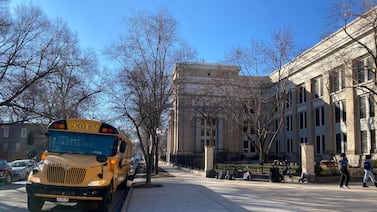Sign up for our free monthly newsletter Beyond High School to get the latest news about college and career paths for Colorado’s high school grads.
For the third year in a row, Colorado’s public college and university leaders have written a letter to the state legislature’s powerful Joint Budget Committee asking for more money than what’s proposed in Gov. Jared Polis’ budget.
Polis wants to increase Colorado’s higher education budget next fiscal year by $42.7 million. In the letter, 15 college and university leaders asked for quadruple the increase: $130.8 million more for their operations next year, plus another $30.6 million for state financial aid. The December letter says the money will help schools increase employee pay and battle inflation without needing to make cuts. Otherwise, they’ll need to raise tuition beyond 2% for in-state and 6% for out-of-state students.
The call for more money comes after Polis said he would work with colleges and universities to keep tuition low and create “greater efficiency,” specifically in administrative costs and ensuring state money goes toward instruction. The Joint Budget Committee has the final say on whether to increase the funding beyond the governor’s request. They have provided schools with more money beyond Polis’ proposal in the last two years.
Colorado’s college and university leaders said they agree with the governor that they need to be good stewards of state money, and they’ve made many cuts since the Great Recession as state investment in higher education dwindled — Colorado funds higher education near the bottom for full-time students. According to a state study, Colorado institutions are more than $900 million below the average funding of their national peers.
Administrative costs might include positions that schools use to comply with federal regulations and reporting requirements, or support for mental health and diversity, equity, and inclusion efforts, according to Tom Harnisch, State Higher Education Executive Officers Association vice president of government affairs. Information technology services are administrative costs.
Nationally and statewide, it’s tricky to calculate how much colleges and universities spend on administrative costs, because each school calculates them differently or not at all, said Richard Vedder, an economist with Ohio University. For example, the Colorado Community College System doesn’t tally administrative costs for its 13 schools. But even if the number is squishy, some research shows the national average spending on administrative costs is 20%, he said.
Recent research suggests administrative costs aren’t a big driver of driving up costs on campuses and reducing affordability to students. Regional colleges and community colleges also tend to be more efficient because they usually have smaller budgets and less wiggle room to spend, Harnisch said.
As Colorado has begun to invest more in higher education in recent years, school leaders have said they’ve found savings in administrative costs while adding services that help students get to and through college.
Some Colorado Community College System schools have cut programs and turned to online instruction to keep costs down. At the CSU System, CSU Fort Collins officials regularly analyze their budgets to shift expenses to other priorities — they’ve reallocated $70 million over 15 years — and the system finds ways to share costs across schools, such as IT expenses.
CSU Fort Collins spends about 7% on administrative costs compared to 22% at peer institutions, said Tony Frank, the CSU System president. Other system schools — CSU Global and Pueblo — have similar cost breakdowns.
Frank said running a university means constant reevaluation, and if school leaders say there’s nothing else they can rework in their budgets to better higher education for students, then “they probably ought to fire all of us.”
Yet efficient spending doesn’t always translate to student results.
Colorado colleges and universities are under pressure to help get more students to graduation and make sure students who don’t graduate aren’t saddled with debt. Colorado also has a workforce shortage and needs more workers who are college educated for the jobs available.
The administrative services that help students get to and through college, like academic or mental health counseling, drive up expenditures, said Dustin Weeden, a SHEEO associate vice president.
That matters because just like in K-12, some students are going to cost more to educate and support, Weeden said. Students who are the first in their families to go to college or come from low-income backgrounds might need more help to graduate.
“The conversation then becomes what is the adequate level of funding needed to educate them,” he said.
To get more students to graduate, Garcia said schools have needed to increase student services as well as pay staff competitive wages.
JBC members have indicated they want to give colleges and universities more money, with Republicans and Democratic members of the committee saying they would like to fund higher education and maintain college affordability.
Legislative leaders also echoed that support, with House Speaker Julie McCluskie, a Dillon Democrat, saying she’s deeply committed to funding higher education.
Once the JBC writes the state budget, the Colorado House and Senate will submit amendments and vote on the budget. The Joint Budget Committee will then ensure it has a balanced budget for a final vote and signature by the governor.
Much will depend on what the state can afford. There are other competing high cost issues this year, including the end of the budget stabilization factor. The state has used the budgetary maneuver to withhold money that should go to K-12 schools to pay for other priorities.
Frank said he commended the governor and other lawmakers for considering increasing state funding for colleges and universities while also demanding that schools make sure state money benefits students the most.
He stressed that pay raises outlined in the letter are important to maintain the quality of instruction and services at schools for students.
“Once that starts to spiral, it’s hard to recruit students,” he said.
Jason Gonzales is a reporter covering higher education and the Colorado legislature. Chalkbeat Colorado partners with Open Campus on higher education coverage. Contact Jason at jgonzales@chalkbeat.org.







